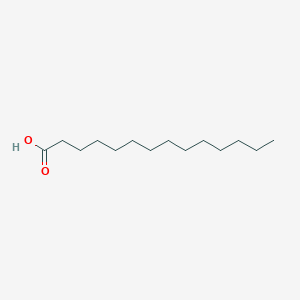Details of the Drug Inactive Ingredient (DIG)
| Full List of Active Pharmaceutical Ingredients (APIs) Co-administrated with This DIG | ||||||
|---|---|---|---|---|---|---|
| ICD Disease Classification 08 | Nervous system disease | Click to Show/Hide | ||||
|
Oxycodone
|
API Info |
Anaesthesia [ICD-11: 8E22]
|
[1] | |||
| Full List of Biological Targets of DIG (DBTs) Regulated by This DIG | ||||||
|---|---|---|---|---|---|---|
| G-protein coupled receptor (GPCR) | ||||||
| DBT Name: GPCR84 receptor (GPR84) | Click to Show/Hide | |||||
| Detailed Information |
DBT Info
 click to show the detail info of this DBT click to show the detail info of this DBT
|
|||||
| Experiment for Assessing the Biological Activity of the Studied DIG on This DBT | ||||||
| Biological Activity | Ki = 2640 nM (tested by experiment) | [2] | ||||
| Tested Species | Homo sapiens (Human) | |||||
| UniProt ID | GPR84_HUMAN | |||||
| Oxidoreductase (ORase) | ||||||
| DBT Name: Prostaglandin G/H synthase 1 (COX-1) | Click to Show/Hide | |||||
| Detailed Information |
DBT Info
 click to show the detail info of this DBT click to show the detail info of this DBT
|
|||||
| Experiment for Assessing the Biological Activity of the Studied DIG on This DBT | ||||||
| Biological Activity | IC50 > 500000 nM (tested by experiment) | [3] | ||||
| Tested Species | Bos taurus (Bovine) | |||||
| UniProt ID | PGH1_BOVIN | |||||
| DBT Name: Prostaglandin G/H synthase 2 (COX-2) | Click to Show/Hide | |||||
| Detailed Information |
DBT Info
 click to show the detail info of this DBT click to show the detail info of this DBT
|
|||||
| Experiment for Assessing the Biological Activity of the Studied DIG on This DBT | ||||||
| Biological Activity | IC50 > 500000 nM (tested by experiment) | [3] | ||||
| Tested Species | Ovis aries (Sheep) | |||||
| UniProt ID | PGH2_SHEEP | |||||
| Hydrolase (HDase) | ||||||
| DBT Name: Dynamin-1 (DNM1) | Click to Show/Hide | |||||
| Detailed Information |
DBT Info
 click to show the detail info of this DBT click to show the detail info of this DBT
|
|||||
| Experiment for Assessing the Biological Activity of the Studied DIG on This DBT | ||||||
| Biological Activity | IC50 > 100000 nM (tested by experiment) | [4] | ||||
| Tested Species | Homo sapiens (Human) | |||||
| UniProt ID | DYN1_HUMAN | |||||
| DBT Name: Toll-like receptor 2 (TLR2) | Click to Show/Hide | |||||
| Detailed Information |
DBT Info
 click to show the detail info of this DBT click to show the detail info of this DBT
|
|||||
| Experiment for Assessing the Biological Activity of the Studied DIG on This DBT | ||||||
| Biological Activity | IC50 = 5000 nM (tested by experiment) | [5] | ||||
| Tested Species | Homo sapiens (Human) | |||||
| UniProt ID | TLR2_HUMAN | |||||
| Nuclear receptor (NR) | ||||||
| DBT Name: PPAR-alpha (PPARA) | Click to Show/Hide | |||||
| Detailed Information |
DBT Info
 click to show the detail info of this DBT click to show the detail info of this DBT
|
|||||
| Experiment for Assessing the Biological Activity of the Studied DIG on This DBT | ||||||
| Biological Activity | IC50 = 5400 nM (tested by experiment) | [6] | ||||
| Tested Species | Homo sapiens (Human) | |||||
| UniProt ID | PPARA_HUMAN | |||||
| DBT Name: PPAR-delta (PPARD) | Click to Show/Hide | |||||
| Detailed Information |
DBT Info
 click to show the detail info of this DBT click to show the detail info of this DBT
|
|||||
| Experiment for Assessing the Biological Activity of the Studied DIG on This DBT | ||||||
| Biological Activity | IC50 = 24000 nM (tested by experiment) | [6] | ||||
| Tested Species | Homo sapiens (Human) | |||||
| UniProt ID | PPARD_HUMAN | |||||
| DBT Name: PPAR-gamma (PPARG) | Click to Show/Hide | |||||
| Detailed Information |
DBT Info
 click to show the detail info of this DBT click to show the detail info of this DBT
|
|||||
| Experiment for Assessing the Biological Activity of the Studied DIG on This DBT | ||||||
| Biological Activity | IC50 = 21000 nM (tested by experiment) | [6] | ||||
| Tested Species | Homo sapiens (Human) | |||||
| UniProt ID | PPARG_HUMAN | |||||
If you find any error in data or bug in web service, please kindly report it to Dr. Zhang and Dr. Mou.

